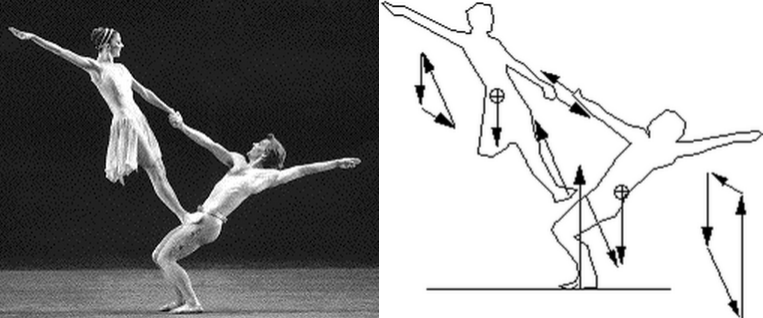Last semester, I picked up Latin and ballroom dancing as a
hobby. All through high school I didn’t dance, but thanks to the recommendation
of a friend I decided to go to free introductory dance lessons. At first it was
just fun to socialize, learn some new steps and practice body coordination, but
I soon grew to love it. Our Latin dance teacher has a particular habit of describing
dance movements in terms of coordinates and physics; rumba walks require your
center of mass over your front foot for balance and look best if you extend the
axis running from your shoulder to opposite leg as far as possible. This mentality
has slowly creeped its way into my brain, and eventually I realized that, hey, dance
really is about physics! You don’t know it while dancing, but every movement
is purposeful when viewed through a pair physics-colored safety glasses.
When first starting to dance, everything is about mechanical
control of your body and constantly asking the question, where is my center of
mass (let's abbreviate it as COM) right now? Of course you wouldn’t consciously ask yourself that, but
even without asking your body will give the answer. While posing still, if your
COM is not somewhere well supported by your limbs, you’ll fall down because relative
to the point of floor contact your bodyweight is generating torque on your COM. On a
single limb, your COM needs to be over the supporting limb to stay balanced. On more than one
limb, your COM should be somewhere between the limbs based on how your bodyweight
is distributed towards each (unless the floor is slippery. Then it’s best to
choose a limb to center over otherwise your supports will simply fall apart and
you’ll hit the floor). When you begin to move horizontally, core muscles contract in order to support your center of mass on its journey from one place
to another through fluid motion.
Spinning generates torque along other axes and accordingly
makes you conscious of where your body axes are. Since torque acts along levers
originating at your COM, all body axes will include your COM. Torque is defined in parallel to Newton’s
second law by the equation
1. τ=Iα (torque equation)
Where τ is torque, I is inertia and a is angular acceleration. Inertia is
related to the distribution of your body mass in space around a rotational axis.
While spinning on an axis perpendicular to the ground like a ballerina or ice
skater, contracting your arms from an extended position can reduce your moment
of inertia and increase your angular acceleration based on the existing torque.
And expanding your body to increase inertia while tilting your axis slightly can
slow your spin and generate a simultaneous forward momentum to get you out of the
spin and into horizontal motion. Manipulating the position of your center of
mass so that it remains relatively stationary while moving around it by torque
is what allows break-dancers to do such complicated flips. Dancing is all a
game of mechanics.
Fig. 1: Dancing as an act of balancing forces (University of Illinois at Urbana-Champaign)
Fig. 1: Dancing as an act of balancing forces (University of Illinois at Urbana-Champaign)
What makes Latin and ballroom dance special to me is that
all of the dances are partner dances. This means double the complication, but
also double the fun! Instead of your COM, your tandem COM is what counts. And all
movements and spins are done together accordingly. What’s even more exhilarating
is that your tandem COM is without your body, so when you go for a partner spin
you’ll both be spinning about an axis between the two of you (assuming equal mass). In Latin
and ballroom dance, a concept that is stressed is partner connection. This means
making sure both of your bodies push against each other at the point of contact
in a way that conveys information about how each of you is moving. What this
also does is make the tandem COM more stable. When partner connection is weak,
your tandem COM can constantly dissolve and reform. This makes both partners unstable
and rely on knowing their own COMs to maintain balance. A strong connection
means both partners can fully commit to the unwavering tandem COM and structure
each motion together. And believe me, you can feel this. It’s really exciting when
you and your partner start to move as one, and not having to worry about your
own balance allows you to focus on the art of the dance.
This post is a little less
reference and math heavy than some of the past ones, which I thought would be a nice break. I just wanted to share what makes Latin
and ballroom dance such a special hobby to me. Dancers out there, please let me know if
you think my description does dance justice in the comments below. Other Thinkers,
I wanna hear your thoughts too. And check out a few minutes of this video of world-class Latin dancers. Thanks guys!

No comments:
Post a Comment